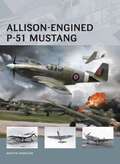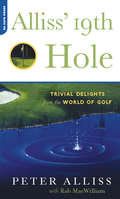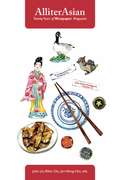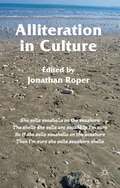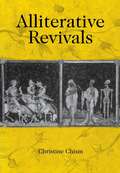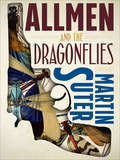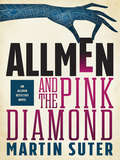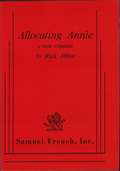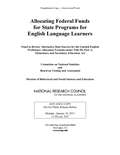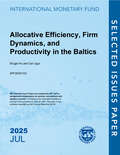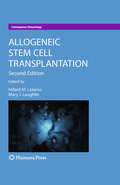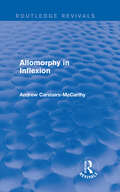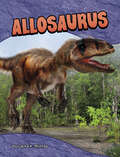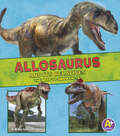- Table View
- List View
Allison to the Rescue (Girl Talk #38)
by L. E. Blair[From The Back Cover] "Someone has to help the animals before it's too late! "When Allison's little brother, Charlie, gets a puppy from the Acorn Falls Animal Shelter, Allison promises to teach Charlie how to be responsible. But when she finds out that the shelter is dangerously overcrowded and dirty, she decides that Charlie isn't the only one who needs to learn something about responsibility." Once you get to know Sabrina, Allison, Katie and Randy you'll want to get in on all of their girl talk. There are over 30 more books in the Girl Talk series in the Bookshare Collection so you can start from the beginning with book #1, Welcome to Junior High, and continue with: #2 Face Off!, #3 The New You, #4 Rebel Rebel, #5 It's All in the Stars, #6 The Ghost of Eagle Mountain, #7 Odd Couple, #8 Stealing The Show, #9 Peer Pressure, #10 Falling in Like, #11 Mixed Feelings, #12 Drummer Girl, #13 The Winning Team, #14 Earth Alert!, #15 On The Air, #16 Here Comes The Bride, #17 Star Quality, #18 Keeping The Beat, #19 Family Affair, #20 Rockin' Class Trip, #21 Baby Talk, #22 Problem Dad, #23 House Party, #24 Cousins, #25 Horse Fever, #26 Beauty Queens, #27 Perfect Match, #28 Center Stage, #29 Family Rules, #30 The Bookshop Mystery, #31 It's A Scream!, #32 Katie's Close Call, #33 Randy and the Perfect Boy, #34 Shape Up, Allison, #35 Katie and Sabrina's Big Competition, # 36 Sabrina and the Calf-Raising Disaster, and #37 Randy's Big Dream. More Girl Talk books are on the way.
Allison's Baby-sitting Adventure (Girl Talk #42)
by L. E. BlairAllison comes up with an idea to help her and her friends win Bradley Junior High's contest to see who can raise the most money to help grant wishes for sick children. All they have to do is find enough kids to baby-sit for and they'll make tons of money. Allison finds out that even the best-made plans can go bonkers!" Once you get to know Sabrina, Allison, Katie and Randy you'll want to get in on all of their girl talk. There are over 30 more books in the Girl Talk series in the Bookshare Collection so you can start from the beginning with book #1, Welcome to Junior High, and continue with: #2 Face Off!, #3 The New You, #4 Rebel Rebel, #5 It's All in the Stars, #6 The Ghost of Eagle Mountain, #7 Odd Couple, #8 Stealing The Show, #9 Peer Pressure, #10 Falling in Like, #11 Mixed Feelings, #12 Drummer Girl, #13 The Winning Team, #14 Earth Alert!, #15 On The Air, #16 Here Comes The Bride, #17 Star Quality, #18 Keeping The Beat, #19 Family Affair, #20 Rockin' Class Trip, #21 Baby Talk, #22 Problem Dad, #23 House Party, #24 Cousins, #25 Horse Fever, #26 Beauty Queens, #27 Perfect Match, #28 Center Stage, #29 Family Rules, #30 The Bookshop Mystery, #31 It's A Scream!, #32 Katie's Close Call, #33 Randy and the Perfect Boy, #34 Shape Up, Allison, #35 Katie and Sabrina's Big Competition, # 36 Sabrina and the Calf-Raising Disaster, #37 Randy's Big Dream. #38, Allison To the Rescue, #39 Katie and the Impossible Cousins. #40 Sabrina Wins Big, and #41 Randy and the Great Canoe Race. More Girl Talk books are on the way.
Allison's Journey (Brides of Webster County)
by Wanda E. BrunstetterAllison Troyer is learning to run an Amish household. She is caught between to equally intriguing young Amish men, both looking to gain her affections.
Allison, Shape Up (Girl Talk #34)
by L. E. Blair[from the back cover:] "Will Allison's new swim team take her away from her friends? Allison is a little nervous when she joins the swim team at the Y after failing the fitness exam at school. But things turn out to be great when she makes a neat new friend, Tory Wickers, and they sign up for a Synchronized Swimming exhibition. Soon Allison becomes so busy that she doesn't have time for anything--not even Randy, Katie, or Sabrina!" Once you get to know Sabrina, Allison, Katie and Randy you'll want to get in on all of their girl talk. There are over 30 more books in the Girl Talk series in the Bookshare Collection so you can start from the beginning with book #1, Welcome to Junior High, and continue with: #2 Face Off!, #3 The New You, #4 Rebel Rebel, #5 It's All in the Stars, #6 The Ghost of Eagle Mountain, #7 Odd Couple, #8 Stealing The Show, #9 Peer Pressure, #10 Falling in Like, #11 Mixed Feelings, #12 Drummer Girl, #13 The Winning Team, #14 Earth Alert!, #15 On The Air, #16 Here Comes The Bride, #17 Star Quality, #18 Keeping The Beat, #19 Family Affair, #20 Rockin' Class Trip, #21 Baby Talk, #22 Problem Dad, #23 House Party, #24 Cousins, #25 Horse Fever, #26 Beauty Queens, #27 Perfect Match, #28 Center Stage, #29 Family Rules, #30 The Bookshop Mystery, #31 It's A Scream!, #32 Katie's Close Call, and #33 Randy and the Perfect Boy. More Girl Talk books are on the way.
Allison-Engined P-51 Mustang
by Martyn Chorlton Adam ToobyNot enough credit is given to Allison-engined variants of one of the world's most famous fighters. We now associate the name "Mustang" with the pretty bubble-canopied fighters which now grace our skies as war birds at Airshows around the world today. There is no doubt that the Merlin engine elevated the Mustang's performance from just being "very good" to "exceptional" and this, in many people's eyes, peaked with the P-51B and P-51C, not the more familiar and most produced version - the P-51D - which comprises the majority seen today. From its inception in early 1940, the development of the fighter, which culminated in the prototype NA-73X launched in October, can only be described as rapid. Before the aircraft had even left the drawing board, the RAF had already placed an order for 320 units, such was the confidence in the design and need for a fighter at the time; from preliminary design to maiden flight had taken just 127 days!By early January 1942, the Mustang was in service with the RAF, flying low-level armed reconnaissance operations over Northern France. This was to be the Mustang's hunting ground all the way up to D-Day and beyond. It had proved to be a highly capable aircraft in this role. While supporting Operation Jubilee over Dieppe, Mustangs were used in a more aggressive capacity for the first time and its first enemy kill was claimed - ironically, the pilot was an American volunteer! The RAF's Allison-engined Mustangs continued to prove their worth from late 1943, flying endless reconnaissance sorties in preparation for the Normandy invasion, and continuing to fly as the Allies slowly pushed eastwards towards Berlin. This was a remarkable service length and, despite later Merlin variants arriving in-theatre, the Mustang I, Ia and II served on the front lines until late 1944. In American hands the Mustang entered service as a dive-bomber designated as the A-36 Apache/Invader. From late 1942 onwards, this type served with distinction in North Africa, both in the ground-attack role and in air-to-air combat, and would do so in the Far East as well. The complete fighter variant was the P-51A which, along with the A-36, served in North Africa and the Far East, excelling in Burma as part of LtCol P. Cochrane's 1st Air Command Group supporting the Chindits. Like their RAF colleagues, the Americans flew the type in the low-level photographic role, designated as the F-6A and F-6B when it continued to serve with the 9th Air Force until the war's end and beyond.
Alliss' 19Th Hole: Trivial Delights from the World of Golf
by Peter Alliss Rab MacwilliamFrom the trivial to the arcane to the bizarre to the hilarious to the tragic, Alliss' 19th Hole is a compulsively readable compendium of golf facts, told in the wry voice of the man Golf Digest called the "best golf commentator ever," the legendary Peter Alliss. Marvel at the accomplishments of golfers who have won a revered place in "Alliss' Hall of Fame," shake your head in disbelief at the chaos that ensues "When Good Golfers Go Bad," and relive "The Great Battles of Golf History. " Take an armchair expedition to "The World's Ten Greatest Holes," learn "Ten Essential Facts About the Hole in One," and see what happens when the green is subject to "Animal Intrusions. " Informed by a deep love of the game and a whimsical eye for detail that will delight and engage anyone who shares his enthusiasm for the game, Alliss' 19th Hole is the perfect book for any duffer who can't get enough links lore.
AlliterAsian: Twenty Years of Ricepaper Magazine
by Allan Cho Jim Wong-Chu Julia LinThis anthology of Asian Canadian writing celebrates the twentieth anniversary of Ricepaper magazine, one of the few publications dedicated to literary writing by Asians outside of Asia. It includes new work by such writers as Joy Kogawa, author of the classic Canadian novel Obasan; Sky Lee, author of Disappearing Moon Café; and Fred Wah, the former poet laureate of Canada. There's also contemporary, cutting-edge fiction from writers such as Doretta Lau, Yasuko Thanh, and Kim Fu, author of For Today I Am a Boy. AlliterAsian is an intriguing collection that reveals the beguiling new literary traditions of the Asian diaspora.
Alliteration in Culture
by Jonathan RoperAlliteration occurs in a wide variety of contexts in stress-initial languages, including Icelandic, Finnish and Mongolian. It can be found in English from Beowulf to The Sun . Nevertheless, alliteration remains an unexamined phenomenon. This pioneering volume takes alliteration as its central focus across a variety of languages and domains.
Alliterative Poetry of the Later Middle Ages: An Anthology (Routledge Library Editions: The Medieval World #52)
by Thorlac Turville-PetreOriginally published in 1989, Alliterative Poetry of the Later Middle Ages is an anthology of texts looking at the tradition of alliterative poetry in medieval English literature. The book presents lesser known alliterative Middle English poems, which are unmodernised and include explanatory footnotes designed to give clarity to the text and enable critical response to the texts. The book illustrates the great range and variety of alliterative verse, both rhymed and unrhymed. The poems range from descriptions of armies, bloody battles, dramatic storms and dreams of goddesses. Whatever the subject, social and political satire, theological controversy and moral admonition is always given a lively and interesting setting. The book contains a succinct and incisive introductory material and a carefully selected bibliography which will encourage further reading.
Alliterative Revivals
by Christine ChismAlliterative Revivals is the first full-length study of the sophisticated historical consciousness of late medieval alliterative romance. Drawing from historicism, feminism, performance studies, and postcolonial theory, Christine Chism argues that these poems animate British history by reviving and acknowledging potentially threatening figures from the medieval past--pagan judges, primeval giants, Greek knights, Jewish forefathers, Egyptian sorcerers, and dead ancestors. In addressing the ways alliterative poems centralize history--the dangerous but profitable commerce of the present with the past--Chism's book shifts the emphasis from the philological questions that have preoccupied studies of alliterative romance and offers a new argument about the uses of alliterative poetry, how it appealed to its original producers and audiences, and why it deserves attention now.Alliterative Revivals examines eight poems: St. Erkenwald, Sir Gawain and the Green Knight, The Wars of Alexander, The Siege of Jerusalem, the alliterative Morte Arthure, De Tribus Regibus Mortuis, The Awntyrs off Arthure, and Somer Sunday. Chism both historicizes these texts and argues that they are themselves obsessed with history, dramatizing encounters between the ancient past and the medieval present as a way for fourteenth-century contemporaries to examine and rethink a range of ideologies.These poems project contemporary conflicts into vivid, vast, and spectacular historical theaters in order to reimagine the complex relations between monarchy and nobility, ecclesiastical authority and lay piety, courtly and provincial culture, western Christendom and its easterly others, and the living and their dead progenitors. In this, alliterative romance joins hands with other late fourteenth-century literary texts that make trouble at the borders of aristocratic culture.
Allmen and the Dragonflies (Allmen)
by Martin Suter&“In the honorable vein of elegant, gentleman thieves, comes Allmen, the colorful protagonist of Suter&’s beautifully observed, deliciously fun novel&” (Noah Charney, author of The Museum of Lost Art). Johann Friedrich von Allmen, a bon vivant of dandified refinement, has exhausted his family fortune. Forced to downscale, Allmen inhabits the garden house of his former Zurich estate, attended by his Guatemalan butler, Carlos. When not reading novels by Balzac and Somerset Maugham, he plays jazz on a Bechstein baby grand. Allmen&’s fortunes take a sharp turn when he meets Jojo, a stunning blonde whose lakeside villa contains five Art Nouveau bowls created by renowned French artist Émile Gallé and decorated with a dragonfly motif. Allmen, seeking to pay off mounting debts, absconds with the priceless bowls and embarks on a high-risk, potentially violent bid to cash them in. This is the first of a series of humorous, fast-paced detective novels devoted to a memorable gentleman thief who, with his trusted sidekick, Carlos, creates an investigative firm to recover missing precious objects. &“A rollicking good time . . . Bestselling Swiss author Martin Suter may have a classic on his hands in this contemporary crime novel, the first of a series featuring the memorable character of Johann Friedrich von Allmen, gentleman thief.&” —The Winnipeg Free Press &“Suter combines sleight-of-hand suspense with stunning art and slightly worn Old World elegance to create a smartly entertaining read . . . A classy puzzler.&” —Library Journal &“The dark charms of Suter&’s novel are irresistible from the first pages.&” —Joshua Max Feldman, author of Start WithoutMe
Allmen and the Pink Diamond (The Allmen Detective Novels)
by Martin SuterWhen a $30 million diamond disappears, the gentleman P.I. embarks on an adventure across Europe in this &“delightfully quirky and original&” mystery (Peter James, author of Dead Simple). A rare pink diamond recently sold at auction has gone missing, and gentleman thief turned private detective Johann Freidrich von Allmen cannot resist the case—even if his butler and business partner Carlos de Leon has his reservations. With suspicion falling on a man named Artyom Sokolov, Allmen and de Leon embark from London to Zurich in search of the mysterious Russian. Soon the two discover that they are up against a conspiracy far more complex and dangerous than they suspected. And as amorous adventures and diverting mishaps litter their path through Europe&’s high society, Allmen and de Leon get closer to uncovering a high-tech plot to manipulate global financial markets.
Allocating Annie: A New Comedy
by Rick AbbotWhen Cliff Tucker inherits an orphan on the eve of his wedding to wealthy Bobbi Ralston, he figures he can handle matters until the foundling turns out to be full grown and gorgeous with an infant in her arms. While Cliff is fielding this disaster, his lawyer, who is in love with Bobbi, plots to scuttle the wedding. Plans backfire and lunacy multiplies when a struggling actor arrives and Cliff's housekeeper/sister lets him move into the apartment Cliff is vacating. Three convoluted romances culminate in a climactic engagement party in the final act that leaves audiences roaring with laugher. The deranged events involve a dress that looks like a Christmas tree, a stuffed monkey subbing for the baby, a telltale birthmark, and a startling dinner entree called "Penguin Wellington." This farce quickly accelerates from amusing to hilarious and is a fine frolic for the entire family to enjoy.
Allocating Decision Rights & Accountability: Elements of Effective IT Governance
by Jeanne W. Ross Peter WeillEvery firm, at some level, needs a digitized platform, or integrated set of electronic business processes, to operate effectively. The only way to deliver a digitized platform--and superior business value from IT--is to design IT decision rights and accountabilities so that daily decisions about IT support the firm's strategic goals. In this chapter, the authors explain the importance of transparency in IT governance and describe how a firm's governance mechanisms clarify how each of five key decisions will be made and who will be held accountable. Having a clear direction in each of the five decision areas will help promote desirable behavior in the management and the use of IT. This chapter was originally published as chapter 5 of "IT Savvy: What Top Executives Must Know to Go from Pain to Gain."
Allocating Federal Funds for Science and Technology
by Development Committee on Criteria for Federal Support of ResearchThe United States faces a new challenge--maintaining the vitality of its system for supporting science and technology despite fiscal stringency during the next several years. To address this change, the Senate Appropriations Committee requested a report from the National Academies of Sciences and Engineering and the Institute of Medicine to address "the criteria that should be used in judging the appropriate allocation of funds to research and development activities; to examine the appropriate balance among different types of institutions that conduct such research; and to look at the means of assuring continued objectivity in the allocation process." In this eagerly-awaited book, a committee of experts selected by the National Academies and the Institute responds with 13 recommendations that propose a new budgeting process and formulates a series of questions to address during that process. The committee also makes corollary recommendations about merit review, government oversight, linking research and development to government missions, the synergy between research and education, and other topics. The recommendations are aimed at rooting out obsolete and inadequate activities to free resources from good programs for even better ones, in the belief that "science and technology will be at least as important in the future as they have been in the past in dealing with problems that confront the nation." The authoring committee of this book was chaired by Frank Press, former President of the National Academy of Sciences (1981-1993) and Presidential Science and Technology Advisor (1977-1981).
Allocating Federal Funds for State Programs for English Language Learners
by National Research Council of the National AcademiesAs the United States continues to be a nation of immigrants and their children, the nation's school systems face increased enrollments of students whose primary language is not English. With the 2001 reauthorization of the Elementary and Secondary Education Act (ESEA) in the No Child Left Behind Act (NCLB), the allocation of federal funds for programs to assist these students to be proficient in English became formula-based: 80 percent on the basis of the population of children with limited English proficiency1 and 20 percent on the basis of the population of recently immigrated children and youth. Title III of NCLB directs the U.S. Department of Education to allocate funds on the basis of the more accurate of two allowable data sources: the number of students reported to the federal government by each state education agency or data from the American Community Survey (ACS). The department determined that the ACS estimates are more accurate, and since 2005, those data have been basis for the federal distribution of Title III funds. Subsequently, analyses of the two data sources have raised concerns about that decision, especially because the two allowable data sources would allocate quite different amounts to the states. In addition, while shortcomings were noted in the data provided by the states, the ACS estimates were shown to fluctuate between years, causing concern among the states about the unpredictability and unevenness of program funding. In this context, the U.S. Department of Education commissioned the National Research Council to address the accuracy of the estimates from the two data sources and the factors that influence the estimates. The resulting book also considers means of increasing the accuracy of the data sources or alternative data sources that could be used for allocation purposes.
Allocating Pensions to Younger People: Towards a Social Insurance against a Short Life
by Gregory PonthiereThis book takes as a starting point that welfare states in developed societies do not provide systems of social insurance against the risk of an early death. In contrast to the way in which economically developed countries provide ways of insuring citizens against other possibilities, such as unemployment and disease, no such social insurance mechanism exists for early death. It aims to demonstrate that, despite the impossibility to compensate the victims of a short life once they are identified, and despite the impossibility to identify the persons who will be short-lived (when they are still alive), it is nonetheless possible to construct a social insurance against the risk of a short life by means of age-based statistical discrimination favouring all young persons. Combining philosophical literature with economic analysis, the book re-examines the ethical foundations of social insurance, and proposes a major reform of the welfare state: the construction of a social insurance against a short life. It shows how such an insurance system could be constructed by partially ‘reversing’ existing pension systems, by offering a period of retirement to all young adults before they start their career. Such a ‘reversed’ pension system would allocate more free time and opportunities to younger members of society before they enter the labour market, and, hence, this system would also improve the lives of the – unidentified – young persons who will turn out to die prematurely. The book discusses the social desirability of this new system, as well as its financial feasibility and societal consequences, examining how pension allowances paid to young adults may be financed by the work of senior workers. As such, this book demonstrates how the universal uncertainty about the duration of life can be reconciled with the idea of social justice. With an accessible and interdisciplinary approach, this book will be of interest to academics working in a range of fields, including economics, public finance, social insurance, the economics of ageing and the welfare state, economic ethics and political philosophy.
Allocation in Networks
by Jens Leth HougaardA comprehensive overview of networks and economic design, presenting models and results drawn from economics, operations research, and computer science; with examples and exercises. This book explores networks and economic design, focusing on the role played by allocation rules (revenue and cost-sharing schemes) in creating and sustaining efficient network solutions. It takes a normative approach, seeking economically efficient network solutions sustained by distributional fairness, and considers how different ways of allocating liability affect incentives for network usage and development. The text presents an up-to-date overview of models and results currently scattered over several strands of literature, drawing on economics, operations research, and computer science. The book's analysis of allocation problems includes such classic models from combinatorial optimization as the minimum cost spanning tree and the traveling salesman problem. It examines the planner's ability to design mechanisms that will implement efficient network structures, both in large decentralized networks and when there is user-agent information asymmetry. Offering systematic theoretical analyses of various compelling allocation rules in cases of fixed network structures as well as discussions of network design problems, the book covers such topics as tree-structured distribution systems, routing games, organizational hierarchies, the “price of anarchy,” mechanism design, and efficient implementation. Appropriate as a reference for practitioners in network regulation and the network industry or as a text for graduate students, the book offers numerous illustrative examples and end-of-chapter exercises that highlight the concepts and methods presented.
Allocative Efficiency, Firm Dynamics, and Productivity in the Baltics: Republic of Estonia
by UgurA report from the International Monetary Fund.
Allogeneic Stem Cell Transplantation: Clinical Research And Practice (Contemporary Hematology)
by Mary J. Laughlin Hillard M. LazarusSince the original publication of Allogeneic Stem Cell Transplantation: Clinical Research and Practice, Allogeneic hematopoietic stem cell transplantation (HSC) has undergone several fast-paced changes. In this second edition, the editors have focused on topics relevant to evolving knowledge in the field in order to better guide clinicians in decision-making and management of their patients, as well as help lead laboratory investigators in new directions emanating from clinical observations. Some of the most respected clinicians and scientists in this discipline have responded to the recent advances in the field by providing state-of-the-art discussions addressing these topics in the second edition. The text covers the scope of human genomic variation, the methods of HLA typing and interpretation of high-resolution HLA results. Comprehensive and up-to-date, Allogeneic Stem Cell Transplantation: Clinical Research and Practice, Second Edition offers concise advice on today's best clinical practice and will be of significant benefit to all clinicians and researchers in allogeneic HSC transplantation.
Allomorphy in Inflexion (Routledge Revivals)
by Andrew Carstairs-McCarthyFirst published in 1987, this book broke new ground in research on inflectional morphology. Drawing on evidence from a wide variety of languages, it shows that this is not just a phenomenon left over from obsolete phonological processes but a subject deserving of respect in its own right. The book proposes constraints in three areas: (1) the organization of inflection class systems; (2) inflectional homonymy, or syncretism; (3) the direction of allomorphic conditioning. Carstairs-McCarthy’s notion of ‘paradigm economy’ revolutionized the study of inflection class systems but in its purest form, presented in this book, the hypothesis was too strong. In more recent works, the author has therefore argued that a version of it is an unexpected by-product of the brain’s aptitude for handling multiple vocabularies. The study of inflectional homonymy was pioneered by Roman Jakobson as evidence for the structuring of morphosyntactic categories or feature sets (case, number, tense, mood and so on) but his approach differed from that of this book, whose radical suggestions fertilized much subsequent work on ‘inflectional identity’. The direction of conditioning, first explored in this text, is debated actively within the Distributed Morphology framework popular within Chomskyan generative linguistics, despite disagreement with the Carstairs-McCarthy view that morphology is a domain of grammar entirely distinct from syntax. In The Evolution of Morphology (2010) the author takes these topics further, and also explains why stem alternation and affixation are importantly distinct as modes of inflectional expression. Inflectional allomorphy is an apparently pointless complication exhibited by many languages. However, this book suggests reasons why it is, nevertheless, easy for the brain to handle. The work thus has important implications beyond language, extending into human cognition.
Alloran's Choice (Animorphs Companion: The Andalite Chronicles, #2)
by K. A. ApplegateElfangor's journey began with a simple mission, but his fellow 'aristh' makes a discovery that takes them all to their home world.
Allosaurus
by Laura K. MurrayAllosaurus ran on two feet and had razor-sharp teeth. But what did it hunt? And why did it have short, bony horns above its eyes? Young readers can get all the facts on this fierce meat-eating dinosaur. Engaging text and images make this book a great choice for information to use in a report or just to read for fun.
Allosaurus and Its Relatives: The Need-to-know Facts (Dinosaur Fact Dig Ser.)
by Megan Cooley PetersonAllosaurus and its relatives were fierce and dangerous predators. Dinosaurs in this group had deadly claws and razor-sharp teeth. Bold, full-color illustrations, easy-to-read charts and maps, and interesting facts take readers back to a time when these fearsome hunters walked the earth. This book supports common core standards.
Allosaurus vs. Brachiosaurus
by Michael O’Hearndinosaurs; battle; preditors; allosaurus; brachiosaurus

